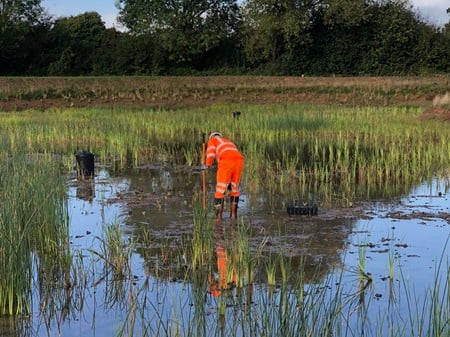AN innovative wetland project in the catchment area of a Wye tributary has been officially opened, with a little help from television’s Kevin McCloud MBE
The writer, designer and presenter, who is best known for fronting Channel 4s Grand Designs, delivered a keynote speech at the opening of the Luston site, north of Hereford, which has been operational for a year, helping to tackle nutrient pollution in local rivers.
High levels of phosphate have long been known to damage the Wye and its tributary, the Lugg, which enters the former at Mordiford between Hereford and Ross.
By 2019 Natural England advised Herefordshire Council that the levels of phosphate in the Lugg sub catchment area meant that in order to protect the river, any new development must fully offset its phosphate load.
Herefordshire Council responded to this with a unique global first in developing the Luston Wetland to capture and remove phosphate, helping to improve the wellbeing of the rivers.

The scheme ensures that more phosphate is removed from the river system than is returned to it through any form of development, and provides a boost to local biodiversity and wildlife, helping to safeguard our natural environment as a county.
The Luston Wetland was initially partly funded by the Local Enterprise Fund’s New Homes Bonus, and the council will recoup costs through developer contributions to reinvest in further wetland sites, the first of which will be at Tarrington.
Llangarron ward councillor Elissa Swinglehurst, Cabinet Member for Environment, said: “It was a delight to be part of Luston’s official opening.
“It’s a great opportunity to reflect on the huge effort and innovative thinking that has gone into developing the wetland project over a number of years.
“The project has delivered wide benefits for biodiversity and has helped to release the potential of 1,000 homes in North Herefordshire, with 620 having already been granted permission.
“Luston Wetland is truly a world first and is already being held up as a national exemplar.
The site is helping us to tackle the critical issue of nutrient pollution and its subsequent economic repercussions; helping the county to close the gap on the housing needs in our Local Plan while staying firm in our commitment to river pollution at its root causes.”
Kevin McCloud added: “Something happened here that is just brilliant, and that is the coming together of people; it is cross-fertilisation of ideas and disciplines.
“This is a beautiful, glorious exemplar that is a huge success. I thoroughly applaud it.”
The River Wye is struggling with high levels of phosphorus entering the watercourse and altering its delicate ecological balance.
It is designated as a Special Area of Conservation (SAC), because of its special features and protected species including crayfish, salmon and otter.
But currently both the Wye and the Lugg are classified by Natural England as being in unfavourable condition and because the River Lugg SAC is exceeding its targets for phosphates, all new development within the Lugg catchment, is required to demonstrate nutrient neutraility.




